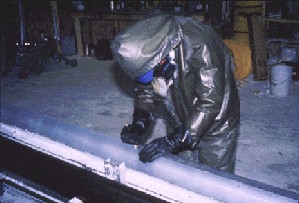How did Jack manage to predict an ice age? How do we dare to predict, how the climate will change or can change? Modern global climate observations have been carried out for only a few decades. This data therefore, provides no basis for conclusions. In the Antarctic and Arctic ice however, one layer of snow after the other has been deposited - summer after summer, winter after winter. Paleoclimatologists can read this information like tree rings and can draw conclusions about past climatic conditions.
|
 |
 |
 |
|
Core logging: Each section was measured and labeled with certain information such as its depth.
Photo: Climate Change Research Center - University of New Hampshire
|
|







